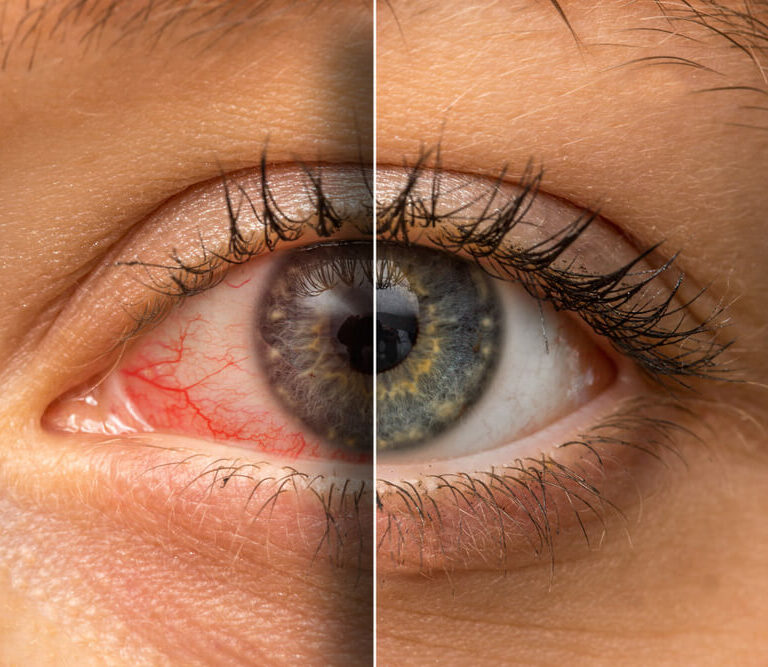Red and bloodshot eyes can look scary, especially if you don’t know what’s caused them, but they are usually nothing to worry about.1 Even something as simple as a ginormous sneeze (yes, really!) can turn the whites of your eyes red.2
Other common causes include allergies, infections, spending hours and hours glued to your computer screen and (whisper it) hangovers.3,4
Read on for lots more on the causes of red and bloodshot eyes, including the ins and outs of how a sneeze can leave your eyes looking red. We’ll also talk about some of the home remedies and other treatments that can help put the sparkle back in your eyes.
Sometimes, though, red eyes can be a sign of something more serious and so we’ll have a look at that too.
Why do eyes get red and bloodshot?
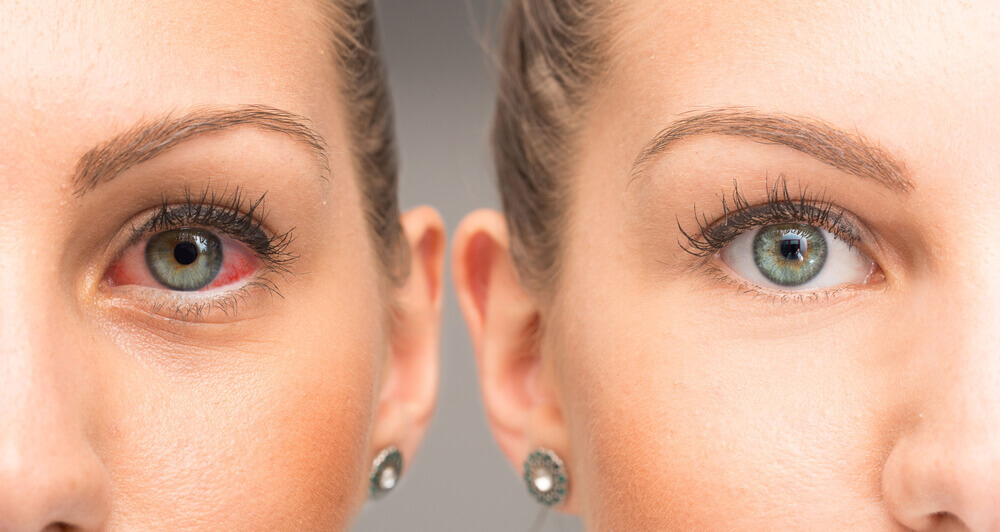
When the tiny blood vessels on the surface of the whites of your eyes become swollen and fill with blood, your eyes are left looking red and bloodshot.5 It can sometimes seem as if you can see every vein in your eyes! Here, we’ll look at 12 of the common causes of red and bloodshot eyes.
Common causes of red and bloodshot eyes
1. Allergies
Hay fever and other allergies can make your eyes red and swollen, as well as itchy and watery. You may also have nasal symptoms, such as sneezing and a runny nose.5

Hay fever is an allergic reaction to pollen and is extremely common, with up to one in five people affected at some point in their life. An allergy to dust or to pets can also leave your eyes red and angry.
Top tip
If your pet pooch or much-loved moggy makes your nose run and your eyes red, try bathing them once a week and keeping them out of your bedroom and off your bed. If you want a pet that doesn’t trigger your allergies, you may have to steer clear of hairy, furry and feathery critters and give a home to a fish, turtle, or even – wait for it – a snake, instead.5,7
2. Conjunctivitis
In a rather colourful turn of events, red and bloodshot eyes can be caused by pink eye! Also known by the medical name conjunctivitis – pronounced con*junk*tiv*eye*tiss – pink eye occurs when the conjunctiva, the lining of the eyelid and the white of the eye, becomes inflamed.
Other signs and symptoms include:5
- Itchy, burning or gritty eyes
- A discharge from your eyes and crusty eyelids or eyelashes
- Sensitivity to light
- More tears than usual
Conjunctivitis is often caused by a bacterial or viral infection and typically affects both eyes. It is also usually very contagious and spreads easily from person to person.5
3. Dry eye
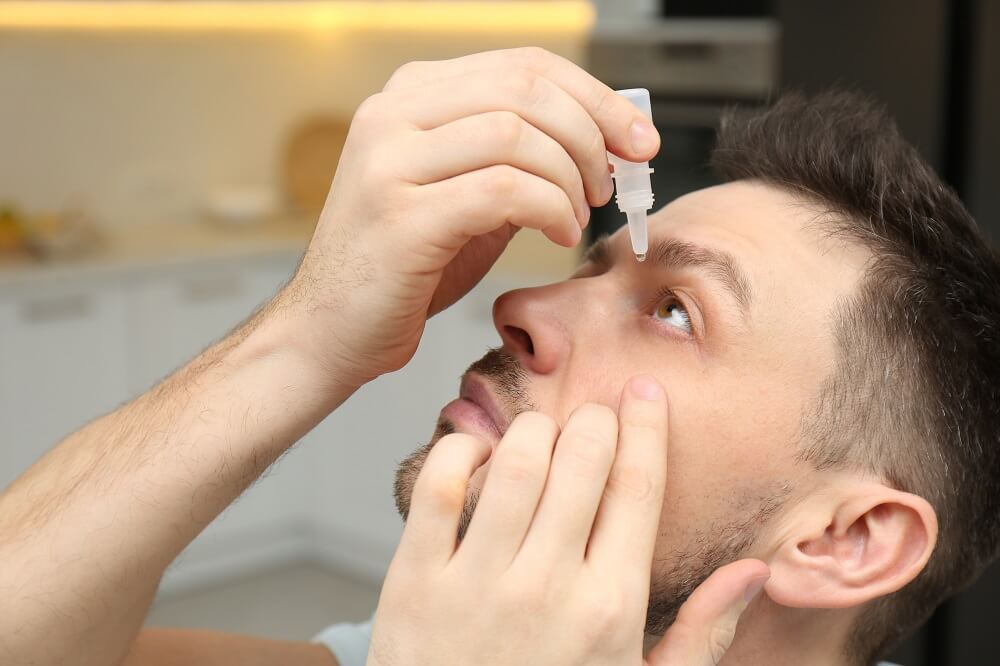
Like its name suggests, dry eye is a condition where the eyes are drier than they should be. This can be because they don’t make enough tears, or the tears evaporate too quickly.8
Most cases are mild but, very rarely, the dryness can cause permanent damage to the surface of the eye.9
Symptoms of dry eyes
The symptoms of dry eye usually affect both eyes and can include:10
- Redness
- Itchiness
- A burning sensation
- Watery eyes
- Heavy feeling eyes
- Blurry vision
- A gritty feeling
- Sensitivity to light
- Eye strain
4. Corneal ulcers
A corneal ulcer is an open sore on your cornea, the clear layer over the coloured part of your eye (your iris). It’s usually caused by an infection and symptoms include:11
- A red, teary, bloodshot eye
- Severe pain
- Sensation of having something in the eye
- Blurred vision
- Sensitivity to light
- Pus
- Swollen eyelids
- A white spot on your cornea
Corneal ulcers can lead to loss of vision, if not treated quickly. So, if you have any of these symptoms, it’s important that you see your GP, optician or ophthalmologist straight away.11
Did you know?
People who wear contact lenses are more likely to get corneal ulcers.11 Tips that cut your chance of a corneal ulcer include never sleeping in your contacts and, simple as it may sound, washing and drying your hands before handling your lenses. Oh, and there are bugs in your mouth that are bad for your cornea, so don’t spit on your lenses to moisten them!11
5. Subconjunctival haemorrhage
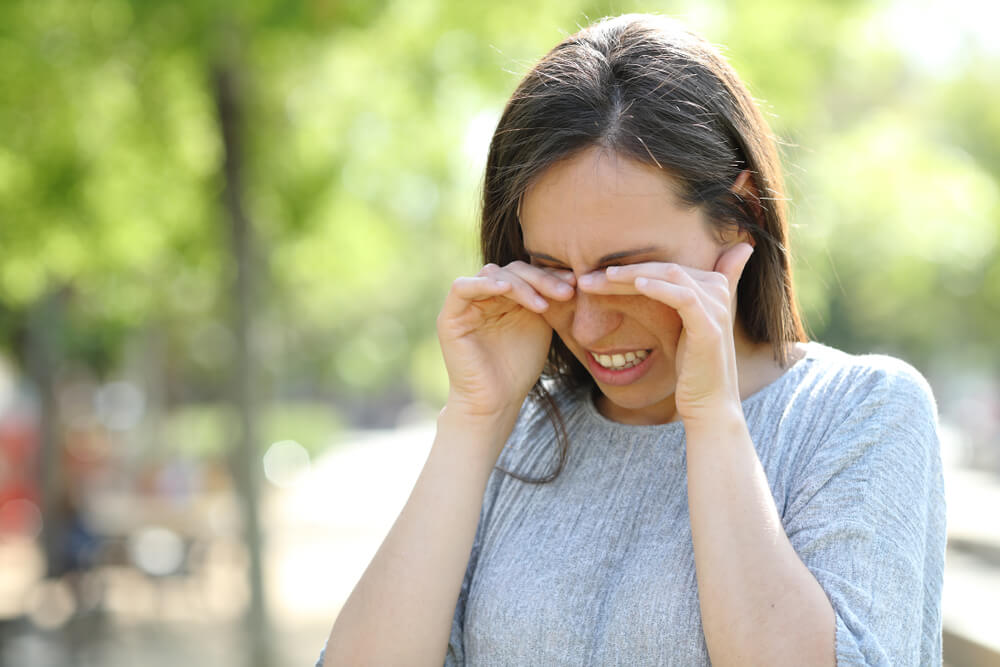
A subconjunctival haemorrhage – a broken blood vessel to you and me – sounds and looks scary but it’s normally harmless and will go away on its own in a week or two.12
It happens when a tiny blood vessel breaks just under the surface of the eye. The blood then pools and forms a bright red patch or spot on the white of the eye.13 This can look alarming, especially if you are taking a common blood-thinning medicine, as these can exaggerate the redness.14
A subconjunctival haemorrhage can be caused by a bad cough, sneeze (yep, that’s where the ginormous sneeze comes in!) or even rubbing your eyes too hard when you have hay fever.13
It shouldn’t affect your vision or be painful though, and, strange as it may seem, you might not even realise you have one until you look in the mirror.13
Fun fact
Sneezes are super-speedy. They can travel at up to 100mph and spray more than 100,000 droplets out into the air.15
6. Blepharitis
Blepharitis, pronounced bleh*fuh*rai*tuhs, the rather grand medical name for red, swollen eyelids, can also make your eyes red.
It’s very common and can be uncomfortable but usually isn’t serious. The tell-tale signs are:16
- Red, swollen, and itchy eyelids
- Gritty or itchy eyes
- Red eyes
- Flakes or crusts around the base of the eyelashes
- Eyelids sticking together when you wake up in the morning
7. Glaucoma
Glaucoma is a condition where the optic nerve, the communication cable between the eye and brain, becomes damaged. This usually happens when fluid builds up in the front of the eye, which increases the pressure of the eye. It can lead to loss of vision if it’s not caught and treated early.17
Glaucoma normally develops gradually over many years but, very occasionally, it can come on suddenly and cause symptoms such as:17
- A red eye
- Severe eye pain
- A headache
- Nausea and vomiting
- Rings or rainbows in your vision
- Blurred vision
Important
Sudden-onset glaucoma, which is more properly known as acute closed-angle glaucoma or acute angle-closure glaucoma, is a medical emergency and if you develop symptoms suddenly, you should go to your nearest eye casualty unit or A&E as soon as you can.17
8. A hangover

If you have ever wondered why a hangover leaves you bleary-eyed, it’s because alcohol makes the tiny blood vessels in your eyes widen. They then fill with blood – which is why your eyes can be bloodshot the morning after the night before.18
You may also find that your eyes get dry and irritated after a big night out. That’s because alcohol is a diuretic, meaning that it removes water from the body, which can cause the symptoms of dry eye.
9. Styes
These tender red lumps form on the very edge of the eyelid when a tiny oil gland near your eyelashes gets infected.19 Your eye – a stye usually only affects one eye – can become red and weepy and very painful. The good news is that styes, which are more common in people with diabetes,20 usually clear up on their own in a week or two.19
10. Too little sleep

It’s not just us that need a good night’s sleep to feel perky, our eyes do too! Lack of sleep can leave eyes red and bloodshot, as well as puffy and sore.21
Top tip
If going back to bed is not an option, however much you wish it is, try this quick fix for sleep-deprived eyes: Place a cold compress over them for ten minutes – if you don’t have a flannel handy, slices of cucumber or even two wet tea bags will do – lie back and relax.21
11. Eye injuries
Something such as shampoo or dust in your eye can be pretty painful but it will often get better on its own within a day or so. But, if you get bleach or another chemical in your eye, or something pierces your eye, you should get medical help.22
12. Sunburned eyes
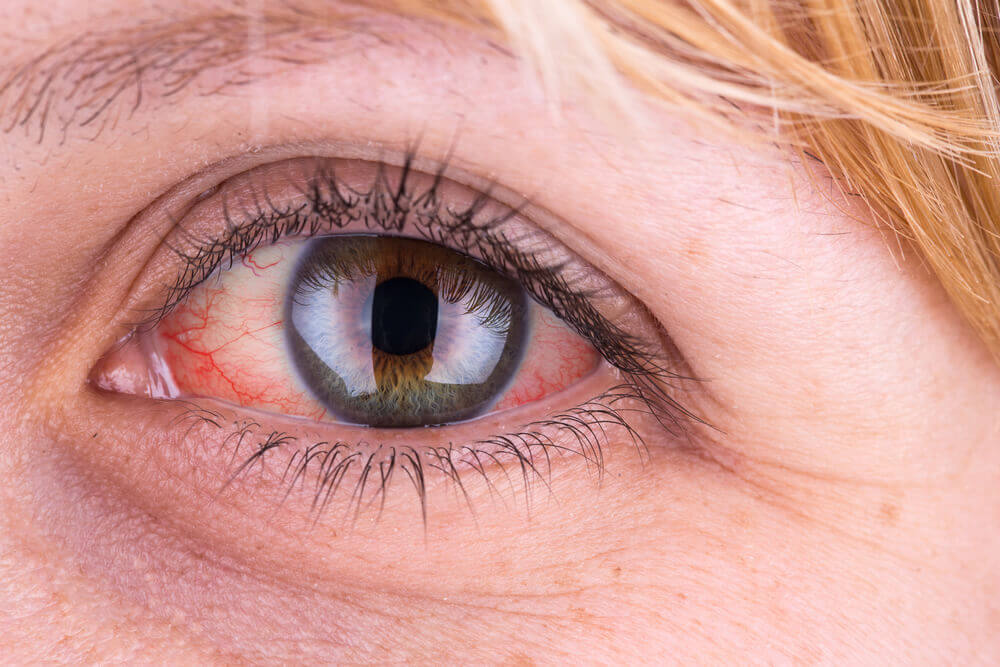
You may want to look away now…because it is possible to sunburn your eyeballs! Sunburned eyeballs, or photokeratitis as medics prefer to call it, can leave our eyes red, dry, itchy, swollen, and sore. Luckily, and much like sunburned skin, it normally heals on its own within a day or two.23
Fun fact
It’s possible to burn your eyes when sitting in the shade. Sand can reflect 25% of the sun’s rays,24 meaning that even if you are seemingly hidden away under a beach umbrella, your skin – and eyes – could still burn.
How to treat red and bloodshot eyes
If your red and bloodshot eyes are due to dry eye, hay fever or another allergy, conjunctivitis, blepharitis or photokeratitis, you may be able to give them the TLC they need at home. Often, a cold compress will help.
You can also try:
- If you have hay fever, your pharmacist can give you antihistamine eye drops to help with redness, itchiness, and watering.26
- If your eyes are red because of dry eye, topping up your tears with eye drops may help. Drops such as Cationorm® help to treat dry eye symptoms such as stinging.
- Not wearing your contact lenses or make-up until your symptoms go away.25
- Managing pre-existing conditions, such as rosacea, dermatitis and dandruff, as this can help with blepharitis.
- Taking an over-the-counter painkiller such as paracetamol or ibuprofen, to help with the pain of sunburned eyes, if you need to.27
When to see a doctor
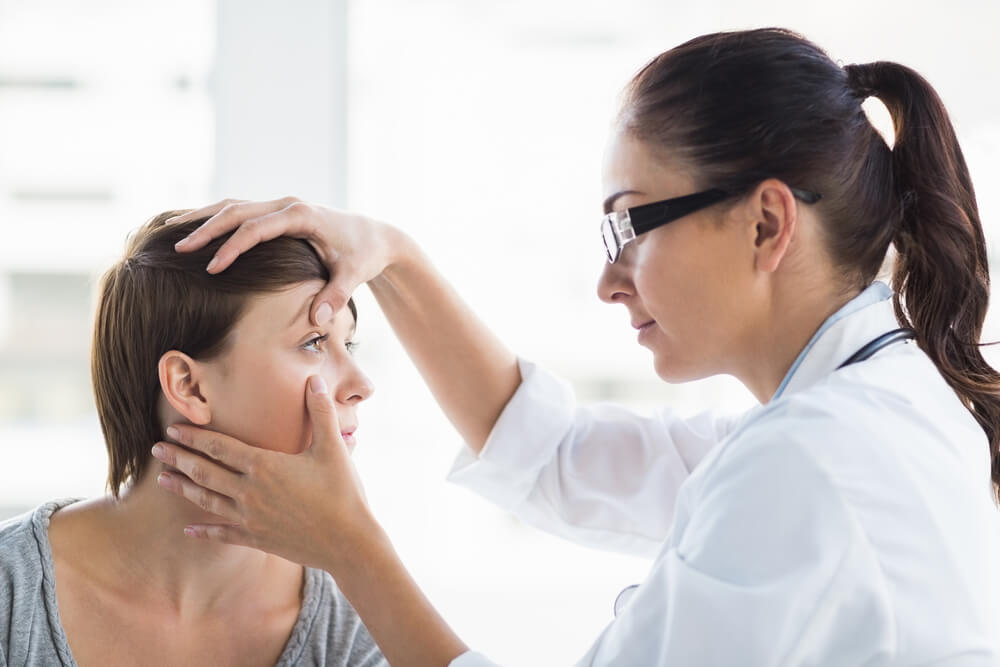
Ask your optician, ophthalmologist, GP or pharmacist for help if you have a red eye that doesn’t start to clear up after a few days.1
Seek help immediately, though, if your eyes are very painful or if you have other symptoms, such as changes in your vision, sensitivity to light, a bad headache or feeling sick. You should also get medical attention if something has pierced your eye or you’ve got a chemical in your eyes.14
How to prevent red and bloodshot eyes
- Take an extra few seconds before jumping into bed to make sure you’ve removed all your eye make-up.28
- Don’t wear contact lenses longer than recommended or when swimming or in the shower.
- Wash your hands often with soap and water for at least 20 seconds (you could try singing “Happy Birthday” twice from beginning to end as you scrub). Hand hygiene is particularly important if a friend, workmate or loved one has conjunctivitis.29
- If you have hay fever, wear wraparound sunglasses to keep pollen out of your eyes.30 Sunglasses are also key in preventing photokeratitis.
- Taking regular screen breaks, taking time to de-stress and cutting back on caffeine and alcohol may all help prevent dry eye.
- To help keep blepharitis away, go easy on eyeliner and don’t use it behind your lashes.31
- If you’ve had conjunctivitis or a stye, throw away your make-up and brushes (try not to think about the cost!) to prevent reinfection.29


